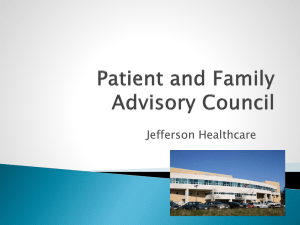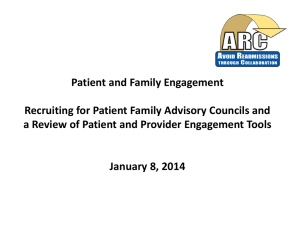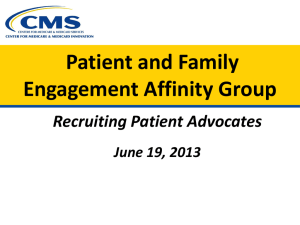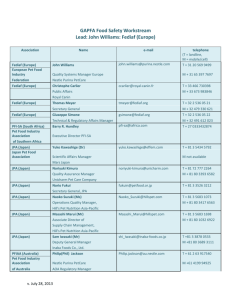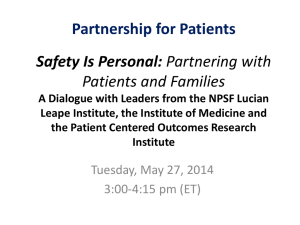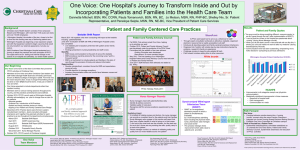HCFA Suggested Patient and Family Advisory Council Annual
advertisement
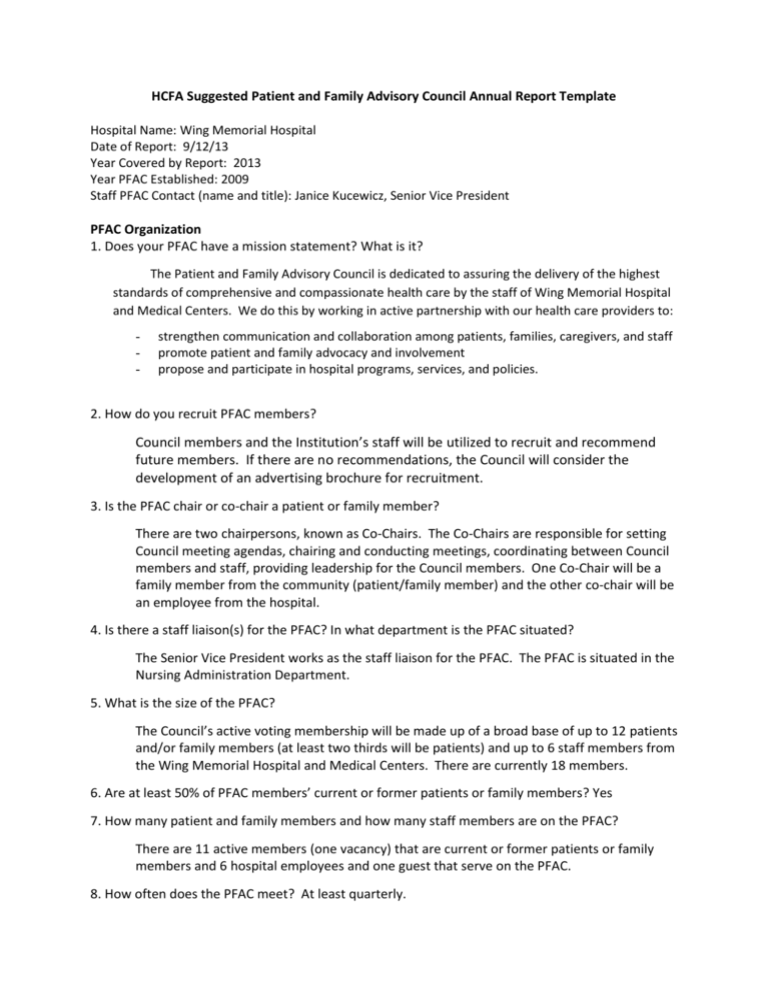
HCFA Suggested Patient and Family Advisory Council Annual Report Template Hospital Name: Wing Memorial Hospital Date of Report: 9/12/13 Year Covered by Report: 2013 Year PFAC Established: 2009 Staff PFAC Contact (name and title): Janice Kucewicz, Senior Vice President PFAC Organization 1. Does your PFAC have a mission statement? What is it? The Patient and Family Advisory Council is dedicated to assuring the delivery of the highest standards of comprehensive and compassionate health care by the staff of Wing Memorial Hospital and Medical Centers. We do this by working in active partnership with our health care providers to: - strengthen communication and collaboration among patients, families, caregivers, and staff promote patient and family advocacy and involvement propose and participate in hospital programs, services, and policies. 2. How do you recruit PFAC members? Council members and the Institution’s staff will be utilized to recruit and recommend future members. If there are no recommendations, the Council will consider the development of an advertising brochure for recruitment. 3. Is the PFAC chair or co-chair a patient or family member? There are two chairpersons, known as Co-Chairs. The Co-Chairs are responsible for setting Council meeting agendas, chairing and conducting meetings, coordinating between Council members and staff, providing leadership for the Council members. One Co-Chair will be a family member from the community (patient/family member) and the other co-chair will be an employee from the hospital. 4. Is there a staff liaison(s) for the PFAC? In what department is the PFAC situated? The Senior Vice President works as the staff liaison for the PFAC. The PFAC is situated in the Nursing Administration Department. 5. What is the size of the PFAC? The Council’s active voting membership will be made up of a broad base of up to 12 patients and/or family members (at least two thirds will be patients) and up to 6 staff members from the Wing Memorial Hospital and Medical Centers. There are currently 18 members. 6. Are at least 50% of PFAC members’ current or former patients or family members? Yes 7. How many patient and family members and how many staff members are on the PFAC? There are 11 active members (one vacancy) that are current or former patients or family members and 6 hospital employees and one guest that serve on the PFAC. 8. How often does the PFAC meet? At least quarterly. 9. Do you reimburse PFAC members for any costs associated with attending meetings and/or provide any other related assistance (eg. free parking, babysitting, etc.). Wing Memorial Hospital provides free parking and a light meal to the PFAC members. 10. Explain how the PFAC membership is representative of the community served by the hospital (demographically and in terms of services utilized at hospital). PFAC members represent the communities that are in Wing Memorial Hospital’s primary service area. Each member brings their own unique experience as a patient or as a family member or sometimes as both. They also act as ambassadors bringing forth comments that they may hear in the community regarding services at Wing Memorial Hospital. 11. Who sets agendas for PFAC meetings? The agenda is set by the Co-Chairs. Any new business may be brought forward at any meeting. 12. Does the PFAC have subcommittees? If yes, please list and describe them. Currently there are no subcommittees. 13. To what extent does the PFAC have access to the hospital Board of Directors? The PFAC has direct access to the hospital Board of Directors through the Senior Vice President as she is an invited guest that attends regularly scheduled meetings. 14. Are PFAC meeting minutes submitted to the hospital board? All minutes of the PFAC are presented to the hospital board. 15. Is there a PFAC section on the hospital website? What is the URL? PFAC has a section on the hospital website. The URL is winghealth.org or through UMassMemorial.org site utilizing the link to Wing Memorial Hospital. 16. To what extent has the PFAC communicated with PFACs at other hospitals? Several members attended the annual PFAC event that was held in May. The Senior Vice President has discussions with other members of the UMass Memorial Health Care Hospital PFACs. Orientation and Continuing Education 17. Describe the PFAC orientation for new members. Include in description how often it is given, by whom, and the content covered. Any new member is provided an orientation to include an overview of the PFAC, HIPPA and confidentiality training, bylaw review, update on hospital programs, publically reported quality data, regulatory agencies that govern the hospital industry, history of PFAC and any other pertinent information. This orientation is completed by the Senior Vice President and other members of the hospital team. Orientations will be completed as needed when new members are appointed to the PFAC. 18. What continuing education was provided to PFAC members this reporting year? Members were educated on the changes in healthcare, continued education on patient satisfaction, Process Improvement, meaning of Transition of Care program, MOLST and new quality indicators. PFAC Impact and Accomplishments (Questions 21-24 below can inform your responses to questions 18 and 19.) 19. On what hospital committees or boards have you placed PFAC members? Was their participation suggested by the committee or by the PFAC? During this fiscal year, one member is participating in the Patient Safety Committee and another member is participating in the Community Needs Assessment Committee. 20. In what ways did the PFAC influence quality of care at this hospital? Describe the PFAC’s accomplishments over the past year. Also note for each initiative undertaken, did the idea arise directly from the PFAC or did a department, committee or unit request PFAC input on the initiatives? (Questions 23-26 below can inform your responses.) The PFAC influenced quality by giving input to the hospital staff on issues that were discussed during the year along with their personal experiences at the organization. Accomplishments for the year included revisions to the Observation Status educational handout that is given to patients (Compliance Director), changes to the doors that lead to the outpatient dialysis unit ( due to a patient complaint through a member), input into the Community Needs assessment ( hospital/ community member), and input on the hospital’s phone system ( patient members). Throughout the year, several members assisted the hospital staff on reviewing patient education materials that will be utilized for patient education and made recommendations in the selection of several brochures. Members provided feedback on patient satisfaction strategies that have been implemented during this year. 21. The law allows a hospital to engage its PFAC in a broad consulting role. Did the PFAC advise the hospital on any of the following areas specifically mentioned in the law (Check or underline all that apply): a. patient and provider relationships b. quality improvement initiatives c. patient education on safety and quality matters 22. Did the PFAC engage in any of the following (mentioned in the law) (Check/underline all that apply): a. reviewers of publicly reported quality information b. members of the Patient Safety Committee 23. Was any of the following public information on hospital performance shared with the PFAC? (Check/underline all that apply.) a. Serious Reportable Events b. Healthcare-Associated Infections c. DPH information on complaints and investigations d. Staff influenza immunization rate e. Other 24. Did PFAC quality of care initiatives relate to any of the following state and/or national quality of care initiatives: (Check/underline all that apply.) a. Healthcare-associated infections b. Public reporting of hospital performance c. Rapid response teams d. Hand-washing initiatives e. Checklists for surgical procedures f. Checklists for nonsurgical procedures g. Disclosure of harm and Apology h. Fall prevention i. Informed decision making/informed consent j. Improving information for patients and families k. Health care proxies/substituted decision making l. End of life planning (e.g., hospice, palliative, advanced directives) m. Care transitions (e.g., discharge planning, passports, care coordination & follow up between care settings) n. Other-please describe – the process for completing a MOLST form with your physician Patient Satisfaction/HCAP score. PFAC Annual Report 25. Do PFAC members participate in the development of the PFAC annual report? Yes 26. Does the hospital share the PFAC annual reports with PFAC members? Yes, they are distributed to members. 27. Did the hospital share the PFAC annual report with the Board of Directors/Trustees? How? Yes, they are distributed to Board members at their regularly scheduled meeting. 28. Do you make the PFAC report accessible to the public? How? Yes – on the hospital website. 29. Is the annual PFAC report posted to the hospital’s website for public access? Yes Goals 30. What goals or quality improvement strategies, if any, has the PFAC set for the coming year? (Please list.) Establish program for PFAC members to visit patients Attend statewide program on PFAC – Members selected Involvement in Emergency Department expansion Development of inpatient on boarding process from the patient/family perspective Continuous updating of PFAC on changes within and to the healthcare industry Development of a PFAC orientation booklet
